Can I Purchase Coffee with Food Stamps? Understanding Your SNAP Benefits
Understanding the intricacies of what your Supplemental Nutrition Assistance Program (SNAP) benefits cover can sometimes feel daunting, especially when everyday items and culinary favorites are concerned. One question that often arises is whether coffee falls within these provisions. For many, coffee is not just a morning ritual but a comforting staple. Let's explore whether you can use SNAP benefits to purchase coffee and unravel the complexities of eligible and ineligible SNAP items.
The Essentials: What Are SNAP Benefits?
To fully appreciate what you can buy with SNAP benefits, it helps to first understand what SNAP is. SNAP, formerly known as food stamps, is a federal program designed to help low-income families and individuals purchase food. The goal is to alleviate food insecurity by supplementing their food-purchasing power.
What SNAP Covers
SNAP benefits can be used to buy a variety of food items that are meant to be taken home and prepared as meals. Generally, this includes:
- Bread and cereals
- Fruits and vegetables
- Meats, fish, and poultry
- Dairy products
- Seeds and plants that produce food
These benefits are designed to ensure that recipients can obtain the necessary nutrients to maintain a healthy diet.
What SNAP Does Not Cover
It's equally important to know what SNAP benefits do not cover:
- Alcohol and tobacco products
- Vitamins and medicines
- Hot foods or foods meant for immediate consumption
- Non-food items like pet foods, soap, paper products, and household supplies
Now, let's look at how coffee fits into this framework.
Buying Coffee with SNAP: What You Need to Know
Coffee, in its basic form, typically falls under the "beverage" category. But not all coffee-related purchases may qualify for SNAP benefits.
Eligible Coffee Purchases
Packaged Coffee, Beans, and Grounds: You can use SNAP benefits to buy packaged coffee, whether it's in the form of whole beans or grounds, as long as it is not hot or meant for instant consumption. This includes:
- Ground coffee
- **Instant coffee jars»
- Whole bean coffee
These products are considered grocery items, not prepared foods, and thus qualify for SNAP purchases.
Ineligible Coffee Purchases
Some coffee-related products are not eligible for purchase with SNAP benefits. These include:
- Hot coffee: Any form of coffee sold hot and ready to drink does not qualify.
- Coffee drinks: Pre-packaged frappuccinos or similar specialty drinks are generally considered non-essential or luxury items.
- Brewed coffee from cafes: Since these beverages are prepared and ready for immediate consumption, they are not eligible.
To sum it up, if the coffee is cold or room temperature, untouched by a barista’s hand, and in packaged form, it is likely SNAP-friendly.
How the Store Affects SNAP Literacy
Where you shop can also impact your buying experience with SNAP benefits. Different stores may have varying signage and classification of products, which can influence your understanding of what items are eligible.
Shopping at Grocery Stores
Most traditional grocery and supermarket chains are set up to accommodate SNAP purchases. They typically label eligible items, making it easier to know whether your coffee purchase qualifies.
Shopping at Convenience Stores
While convenience stores accepted SNAP benefits, they may not always provide the same level of labeling clarity. It's beneficial to ask store employees if you're uncertain whether the coffee you wish to purchase is covered.
Strategies to Maximize SNAP Benefits
Navigating the world of grocery shopping with SNAP can take some getting used to, but here are some strategies to help you maximize your benefits:
Make a List: Identify items that are eligible before going shopping. This saves time and simplifies decision-making in-store.
Know the Store Layout: Familiarize yourself with the stores you frequent, paying close attention to where eligible items, like packaged coffee, are located.
Check Labels: Look for SNAP-eligible labels on shelves or ask an employee if you're unsure about a particular product.
Plan Meals: Planning meals for the week allows you to stretch your benefits while ensuring nutritious meals.
Grow Your Own: For those with a green thumb, using benefits to buy seeds or plants that produce food can supplement your diet with fresh ingredients.
Economic Impact of Coffee Purchases with SNAP
The discussion around what can be bought with SNAP benefits sometimes involves broad economic perspectives. Some argue the importance of being able to purchase coffee as it is a common household item. While SNAP primarily aims to combat hunger, including a variety of household staples like coffee can support routine and comfort, further aiding in creating a balanced and health-conscious diet.
Summary Points: Can I Buy Coffee with SNAP? ☕💡
- Yes, you can buy: Packaged coffee, grounds, and beans.
- No, you cannot buy: Hot coffee, ready-to-drink beverages, and brewed onsite coffee.
- Check Store Labels: Look for SNAP-eligible identifiers and ask when unclear.
- Plan Ahead: Meal and shopping planning can make benefits go further.
Purchasing coffee with SNAP benefits is possible, provided the product meets eligibility criteria. By understanding these parameters and strategically navigating the supermarket aisles, recipients can ensure their SNAP benefits support a well-rounded and satisfying grocery haul. Making informed choices empowers you to comfortably use SNAP benefits, fitting both nutritional needs and personal preferences into your everyday life.

Related Topics
- Am I Eligible For Food Stamps
- Are Food Stamps Being Cut
- Are Food Stamps Federal Or State
- Are Food Stamps Frozen
- Are Food Stamps Funded By Taxpayers
- Are Food Stamps Going Away
- Are Food Stamps Income Limits
- Are Food Stamps Paused
- Are Illegal Aliens Eligible For Food Stamps
- Are Illegal Immigrants Eligible For Food Stamps